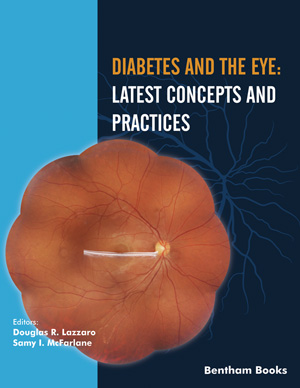Book Volume 2
Preface
Page: ii-ii (1)
Author: Douglas R. Lazzaro and Samy I. McFarlane
DOI: 10.2174/9789811466465121020002
List of Contributors
Page: iii-iii (1)
Author: Douglas R. Lazzaro and Samy I. McFarlane
DOI: 10.2174/9789811466465121020003
Diabetes Epidemic, Epidemiology, Statistics and Trends
Page: 1-12 (12)
Author: Andrew M. Hendrick
DOI: 10.2174/9789811466465121020004
PDF Price: $15
Abstract
The incidence of diabetes mellitus is increasing worldwide. Over time, diabetes is associated with the development of diabetic retinopathy, a major cause of vision loss globally. Research has demonstrated factors associated with the onset and progression of the disease. Despite advancements in understanding the importance of optimizing care, the cases of vision loss due to diabetic retinopathy are also increasing. The epidemic of this systemic disease and the retinal manifestations will be discussed in detail in this chapter.
Recent Developments in Diabetes Evaluation and Management: Implications for the Practicing Clinicians
Page: 13-51 (39)
Author: Anna Y. Groysman, Lina Soni, Samara Skwiersky and Samy I. McFarlane
DOI: 10.2174/9789811466465121020005
PDF Price: $15
Abstract
Diabetes is a major public health problem affecting millions of people around the globe. In the United States alone, over 7.5 million have type 2 diabetes and an alarming 78 million adults have prediabetes and remain largely undiagnosed. This epidemic was ushered in by the ongoing epidemic of obesity and is caused in-part by sedentary life style and aging population. In this chapter we discuss the diabetes epidemic highlighting the major risk factor of diabetes, particularly type 2. We also discuss the complications of diabetes including microvascular complications as well as macrovascular disease including coronary heart disease and stroke, the major cause of morbidity and mortality in the diabetic population. Finally, we present the major therapeutic advances in diabetes including modern pharmacologic agents and their potential effects on cardiovascular risk. We also outline the recent technological advances in diabetes management including closed loop systems, artificial pancreas, stem cell therapy among other ongoing research bound to prevent and/or alleviate the effects of this ongoing epidemic.
Blurred Vision in the Diabetic Patient – Reversible and Non-reversible Causes – General Classification of Diabetic Eye Disease
Page: 52-70 (19)
Author: Rony Gelman
DOI: 10.2174/9789811466465121020006
PDF Price: $15
Abstract
In this chapter, we review the established classification system of diabetic retinopathy and diabetic macular edema. Reversible and non-reversible causes of vision loss in diabetic patients are discussed with illustrative clinical examples.
Diabetes and Ocular Infections
Page: 71-79 (9)
Author: Jennifer Lopez and Allison E. Rizzuti
DOI: 10.2174/9789811466465121020007
PDF Price: $15
Abstract
This chapter will review some of the infections that can be seen in and around the eye in diabetic patients. Specifically, six cases of infection will be highlighted and discussed.
Neuro-Ophthalmic Complications of Diabetes Mellitus
Page: 80-86 (7)
Author: Julie DeBacker and Alessandro Albano
DOI: 10.2174/9789811466465121020008
PDF Price: $15
Abstract
Eye disease attributed to Diabetes can have devastating effects on all aspects of vision as all parts of the eyes are subject to damage including the optic nerve and cranial nerves. In this chapter, we will discuss the most common neuro-ophthalmic problems seen in diabetic patients.
Overview of Anterior and Posterior Segment Complications
Page: 87-105 (19)
Author: Steven Agemy, Zaki Azam and Eric Shrier
DOI: 10.2174/9789811466465121020009
PDF Price: $15
Abstract
Diabetic eye disease is a potential vision-threatening condition. The most well-known complication of uncontrolled diabetes is diabetic retinopathy, but diabetes can affect various structures of the globe other than the retina. Anterior segment complications include ocular surface disease, which includes Dry Eye Syndrome and diabetic keratopathy, cataracts, refractive changes, extraocular movement disorders, and neovascular glaucoma. Posterior segment complications include diabetic papillopathy and retinopathy. Diabetic retinopathy causes vision loss in multiple ways including macular edema and ischemia, vitreous hemorrhage, and retinal detachment. Tight glucose control can help to prevent these complications from occurring.
Diabetes and the Cornea
Page: 106-127 (22)
Author: Lucy Sun and Douglas R. Lazzaro
DOI: 10.2174/9789811466465121020010
PDF Price: $15
Abstract
Diabetes affects the eye in many ways. We most commonly think of posterior segment complications as the main problem causing loss of vision in diabetes which is certainly the most common way people suffer ocular damage. However, the anterior segment is not immune to diabetic complications, and the cornea can be affected in a variety of ways. The manifestations of the corneal disease will be discussed in detail in this chapter.
Diabetes, Cataract, and Glaucoma
Page: 128-146 (19)
Author: Frank Cao and John Danias
DOI: 10.2174/9789811466465121020011
PDF Price: $15
Abstract
Diabetes Mellitus (DM) affects many parts of the eye. While we traditionally associate vision loss from DM with diabetic retinopathy, it can affect various structures of the eye other than the retina. In this chapter, we will focus on the disease’s effects on the lens, and on the drainage apparatus of the eye. Specifically, we will look at cataract and glaucoma incidence in DM and its etiologic role, and then discuss treatment strategies.
Optical Coherence Tomography and Fluorescein Angiography in Diabetic Retinopathy
Page: 147-170 (24)
Author: Sruthi Arepalli, Justis P. Ehlers and Peter K. Kaiser
DOI: 10.2174/9789811466465121020012
PDF Price: $15
Abstract
The assessment and monitoring of diabetic retinopathy are aided by multiple imaging techniques, including optical coherence tomography, optical coherence tomography angiography, and fluorescein angiography. We will discuss each modality in this chapter.
Classification of Proliferative and Non- Proliferative Diabetic Retinopathy and its Implications
Page: 171-184 (14)
Author: Ferhina S. Ali and Sunir J. Garg
DOI: 10.2174/9789811466465121020013
PDF Price: $15
Abstract
An understanding of the classification scheme of nonproliferative and proliferative diabetic retinopathy is essential for the proper management of diabetic eye disease. The level of retinopathy is based on clinical findings seen on fundus examination.
Current Treatment for Diabetic Retinopathy
Page: 185-202 (18)
Author: Joseph Bogaard and Judy E. Kim
DOI: 10.2174/9789811466465121020014
PDF Price: $15
Abstract
This chapter will review most common therapies currently used for diabetic retinopathy. Specifically, the treatments being used for diabetic macular edema (DME) and proliferative diabetic retinopathy will be discussed.
Future Direction in Diabetic Eye Disease
Page: 203-224 (22)
Author: Gautam Vangipuram and Gaurav K. Shah
DOI: 10.2174/9789811466465121020015
PDF Price: $15
Abstract
Diabetic retinopathy is one of the leading causes of vision loss worldwide and its incidence is only projected to increase. Much effort has been dedicated to investigating new therapies and drug delivery approach in treating its complications, diabetic macular edema (DME) and proliferative diabetic retinopathy (PDR). Although anti-vascular endothelial growth factor (VEGF) has gained popularity in treatment for DR, patients who respond poorly to intravitreal injections have prompted the search for additional pathogenic pathways and thus therapeutic targets that may better control disease activity. These novel therapies, including various anti-angiogenic agents, growth factor inhibitors, integrin inhibitors, sustained delivery platforms, gene therapy, chemokine and other inflammatory inhibitors, and neuroprotective agents, are currently being evaluated for the management of DR. Optimal treatment paradigms in the management of PDR are also under investigation.
Subject Index
Page: 225-234 (10)
Author: Douglas R. Lazzaro and Samy I. McFarlane
DOI: 10.2174/9789811466465121020016
Introduction
Diabetes and the Eye familiarizes the reader with the relationship between diabetes mellitus and the visual system. It presents a discussion about the diabetes epidemic and the many ways the disease can cause vision loss, with several types of vision disorders covered in separate chapters. Information about new frontiers in the treatment of ophthalmic disorders is also presented to reflect the advances being made in the clinic. Key features: - presents detailed coverage of vision loss in diabetes in 12 organized and easy to read chapters - includes a discussion on the diabetes epidemic - covers a wide range of vision disorders, of different parts of the eye - includes information on current practices in eye care and management for diabetic patients - includes information about relevant diagnostic tools This book serves as a useful handbook for medical students, residents in ophthalmology, community and academic ophthalmologists, as well as members of the internal medicine and family practice communities.






















